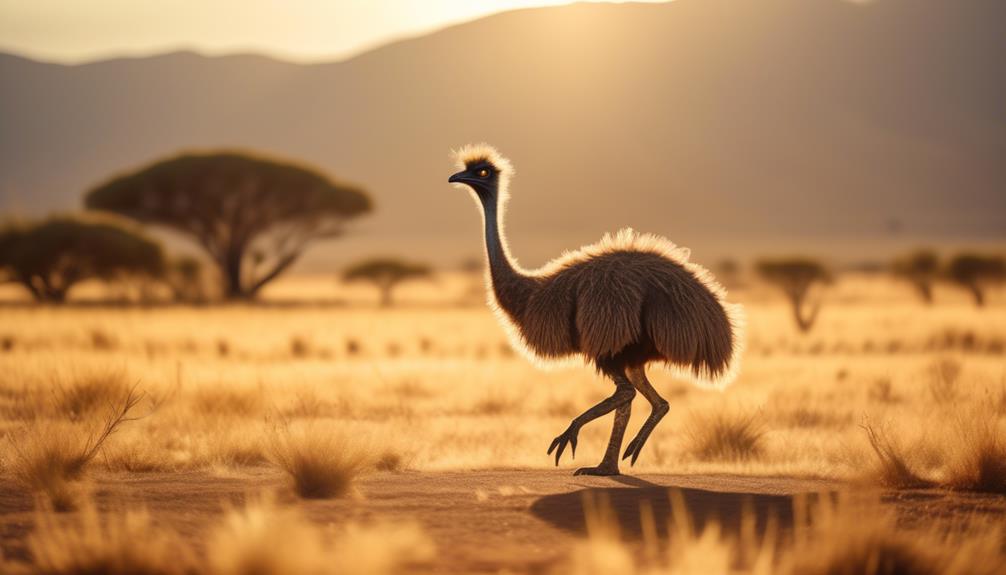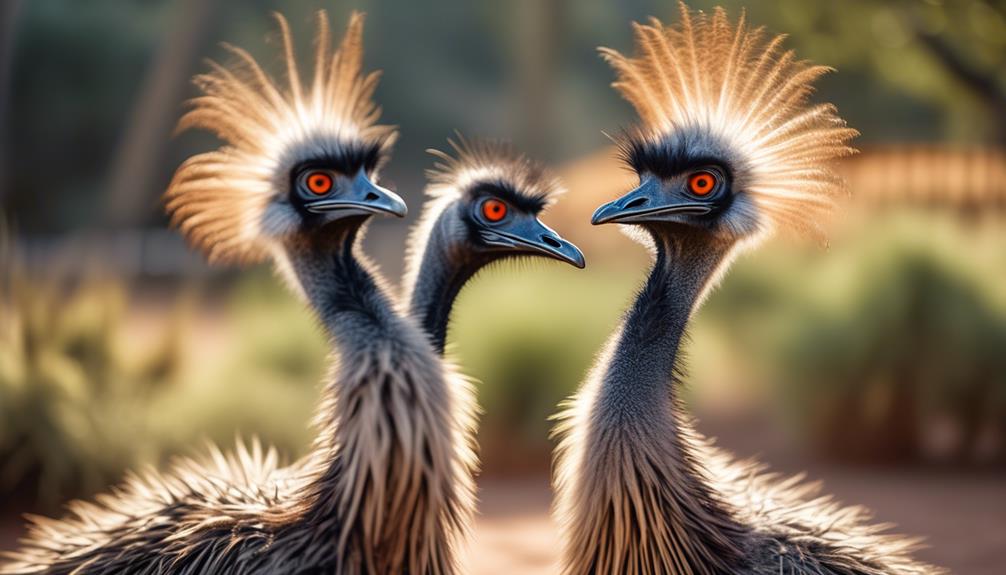
Have you ever wondered about the conservation efforts and challenges facing emus in the wild? With their unique appearance and fascinating behaviors, these flightless birds have captured the interest of researchers and conservationists alike.
But what exactly are the threats they face, and how are we working to protect them? In this discussion, we will explore the truth behind the theories surrounding emu conservation, uncover the challenges they encounter, and discover the innovative strategies being employed to safeguard their future.
So, let's dive into the world of emus and uncover the complexities of their conservation efforts.
Key Takeaways
- Emus play a crucial role in the ecosystem as keystone species, aiding in seed dispersal and serving as indicators of ecosystem health.
- Monitoring emus provides valuable information about habitat quality, food availability, and ecosystem stability, which can inform conservation decisions and strategies.
- Habitat destruction and fragmentation, caused by urbanization and infrastructure development, pose significant threats to emu populations by disrupting their habitats and food sources.
- Emus face threats from predators such as dingoes, foxes, and feral cats, requiring management strategies like fencing, culling, trapping, and baiting to mitigate their impact.
The Importance of Emu Conservation
Emu conservation is of utmost importance in ensuring the preservation of this iconic bird species and its vital role in maintaining ecosystem balance. The importance of emu conservation lies in the significant impact these birds have on their environment. Emus are considered keystone species, meaning they play a crucial role in the functioning of their ecosystem.
One of the key reasons for prioritizing emu conservation efforts is the role they play in seed dispersal. Emus have a unique digestive system that allows them to consume a wide variety of plants, including seeds. These seeds pass through their digestive tract and are then dispersed through their feces. This process aids in the regeneration and distribution of plant species, contributing to overall ecosystem health.
Moreover, emu populations also serve as indicators of ecosystem health. By monitoring emu populations, scientists can gain insights into the state of the environment, including factors such as habitat quality, food availability, and overall ecosystem stability. This information is crucial for making informed conservation decisions and implementing strategies to protect not only emus but also the entire ecosystem.
Emu Habitat Destruction and Fragmentation
The degradation and fragmentation of emu habitats pose significant challenges to their survival and the overall health of the ecosystems they inhabit. As human activities continue to encroach upon natural habitats, emus face the risk of losing their homes and essential resources.
Here's a closer look at the impact of habitat destruction and fragmentation on emus:
- Habitat restoration: Efforts are underway to restore and protect emu habitats through various conservation initiatives. These projects aim to rehabilitate degraded areas, enhance biodiversity, and provide suitable conditions for emus to thrive.
- Urbanization impact: The expansion of urban areas has led to the destruction and fragmentation of emu habitats. Urbanization brings with it infrastructure development, agriculture, and other human activities that disrupt the natural ecosystems emus rely on. This disruption can result in a loss of food sources, nesting grounds, and safe corridors for emus to move between patches of habitat.
- Ecosystem health: The degradation and fragmentation of emu habitats not only affect emus but also have wider implications for ecosystem health. Emus play a crucial role in seed dispersal and vegetation management, and their absence can disrupt the balance of the ecosystem.
To ensure the long-term survival of emus, it's essential to address habitat destruction and fragmentation through habitat restoration and sustainable urban planning. By protecting and restoring their habitats, we can help secure a future for emus and the ecosystems they inhabit.
Threats to Emus From Predators

Predators pose a significant threat to the survival of emus in the wild. Managing predator populations is crucial for maintaining the delicate balance of emu population dynamics. Predation can have a significant impact on emu populations, especially when predators target young emus or their eggs. To better understand the threats posed by predators and the need for predator management, let's take a look at the table below:
| Predator | Impact on Emu Population | Management Strategies |
|---|---|---|
| Dingoes | High | Fencing, culling |
| Foxes | Moderate | Trapping, baiting |
| Feral cats | Moderate | Trapping, neutering |
Efforts to manage predator populations aim to reduce the predation pressure on emus. Fencing can be effective in keeping dingoes out of emu habitats, while culling programs help control their numbers. Trapping and baiting are commonly used to manage fox populations, as they can be a threat to both young emus and their eggs. Similarly, feral cats are known to prey on emus, and trapping and neutering programs are implemented to keep their populations in check.
Human-Emu Conflict and Its Impact
To further explore the challenges faced by emus in the wild, it's important to examine the conflict that arises between humans and emus and the subsequent impact it has on both parties.
Human-wildlife conflict is a complex issue that arises when the interests of humans and wildlife collide, often leading to negative consequences for both sides. In the case of emus, human-emu conflict has several implications:
- Crop damage: Emus are known to feed on crops, causing significant financial losses for farmers. This conflict often arises when emus venture into farmland in search of food, resulting in damage to agricultural produce and economic hardship for farmers.
- Road accidents: Emus are large, flightless birds that can pose a risk to road users. Collisions between emus and vehicles can cause damage to property and, in some cases, lead to injuries or fatalities for both humans and emus.
- Conservation challenges: Human-emu conflict can also have implications for the conservation of these majestic birds. As conflicts escalate, there's a risk of negative attitudes towards emus and a decrease in community support for conservation efforts.
Addressing human-emu conflict requires community engagement and the development of proactive strategies. By promoting awareness, implementing effective fencing techniques, and exploring alternative land management practices, we can strive to mitigate conflict and ensure the coexistence of humans and emus in the wild.
Emu Breeding and Reproduction Challenges

Breeding and reproduction challenges pose significant obstacles for emus in the wild.
Emu breeding challenges arise due to various factors that affect their reproductive success. One major obstacle is the male emu's inability to determine the fertility of the female before mating. Unlike other avian species, emus lack external genitalia, making it difficult to assess the female's reproductive condition. This uncertainty can lead to unsuccessful mating attempts and wasted energy.
Additionally, emu breeding also faces reproduction obstacles due to the female's limited reproductive window. Female emus only lay a clutch of eggs once a year, which reduces their chances of successful reproduction.
Moreover, emus face challenges in incubating their eggs. The male emu is responsible for incubating the eggs, but this task can be demanding and time-consuming. The male emu must endure long periods of incubation without feeding, leaving him vulnerable to predation.
Furthermore, successful hatching isn't guaranteed, as natural predators, environmental factors, and human disturbances can disrupt the incubation process.
These emu breeding challenges and reproduction obstacles highlight the delicate nature of emu reproduction and the need for conservation efforts to safeguard their population.
Disease and Health Concerns in Emu Populations
Disease prevention and population management are crucial for maintaining the health and well-being of emu populations in the wild. Here are three key concerns that need to be addressed:
- Avian Influenza: Emus are susceptible to avian influenza, a viral disease that can cause severe respiratory distress and lead to high mortality rates. Outbreaks of avian influenza can have devastating effects on emu populations, making it essential to implement strict biosecurity measures to prevent the transmission of the virus.
- Parasitic Infections: Emus can be affected by various parasites, including internal worms and external parasites like mites and ticks. These parasites can cause weight loss, anemia, and skin irritations, negatively impacting the overall health of emus. Regular deworming and parasite control measures are necessary to minimize the impact of these infections.
- Newcastle Disease: Newcastle disease is a highly contagious viral disease that affects a wide range of bird species, including emus. It can cause respiratory, gastrointestinal, and nervous system problems, leading to high mortality rates. Vaccination programs and strict quarantine measures are essential for preventing the spread of Newcastle disease within emu populations.
Conservation Strategies and Initiatives

Conservation strategies and initiatives play a vital role in safeguarding the future of emu populations in the wild. In order to protect these iconic birds, efforts are being made to secure conservation funding and implement effective conservation measures, such as captive breeding programs.
Conservation funding is crucial for supporting research, habitat restoration, and community engagement programs aimed at preserving the emu's natural habitat. These funds are used to conduct scientific studies to better understand the needs and behaviors of emus, as well as to monitor their populations and implement conservation actions accordingly. By investing in conservation funding, we can ensure that adequate resources are available to protect and conserve emu populations.
Captive breeding programs have emerged as a key conservation strategy to bolster emu populations. These programs involve the breeding and rearing of emus in controlled environments, such as zoos or specialized facilities. By breeding emus in captivity, we can enhance genetic diversity and create a reserve population that can be used to reintroduce individuals into the wild if necessary.
Captive breeding programs also provide an opportunity for researchers to study emus up close and develop effective management strategies for their conservation.
Monitoring Emu Populations in the Wild
To effectively monitor emu populations in their natural habitat, scientists employ a variety of techniques to gather accurate data on their numbers and distribution. Here are three key methods used in wildlife tracking and population monitoring:
- Radio telemetry: This technique involves attaching small radio transmitters to emus, allowing researchers to track their movements and gather information on their habitat preferences and behavior. By tracking individual emus, scientists can estimate population size, monitor breeding patterns, and identify potential threats.
- Camera trapping: Camera traps are strategically placed in areas where emus are likely to pass by. These motion-activated cameras capture images or videos of emus, providing valuable insights into their population density, activity patterns, and interactions with other species. This non-invasive method helps scientists assess the health and distribution of emu populations.
- Citizen science initiatives: Engaging the public in monitoring emu populations can greatly enhance data collection efforts. Citizen science projects involve volunteers reporting sightings of emus or providing information on emu behavior and habitat use. These contributions help scientists gather data over large geographic areas and increase the overall accuracy of population monitoring.
Research and Technology Advancements in Emu Conservation

Recent advancements in research and technology have significantly contributed to the conservation efforts for emus in their natural habitat. Through research collaborations and technological advancements, scientists and conservationists have gained valuable insights into the behavior, habitat preferences, and population dynamics of emus, enabling more effective conservation strategies.
One of the key technological advancements in emu conservation is the use of GPS tracking devices. These devices allow researchers to monitor the movement patterns and home ranges of emus, providing important information about their habitat requirements and potential threats they may face. By understanding their preferred habitats, conservation efforts can be focused on protecting these areas and ensuring their long-term survival.
Furthermore, advances in genetic research have helped scientists understand the genetic diversity and population structure of emus. This knowledge is crucial for implementing effective breeding programs and managing captive populations to maintain genetic health and prevent inbreeding.
Another area of technological advancement is the use of remote sensing and satellite imagery. These tools provide valuable information about the distribution and extent of emu habitats, allowing for targeted conservation efforts in areas of high conservation value.
Community Involvement and Education Programs
Community involvement and education programs play a crucial role in fostering awareness and understanding of emu conservation, promoting active participation, and empowering local communities to contribute towards the preservation of this iconic species.
Through community engagement and outreach programs, individuals are provided with opportunities to learn about the unique characteristics and ecological importance of emus. These programs aim to create a sense of connection and responsibility towards the conservation of these birds.
Here are three ways in which community involvement and education programs contribute to the preservation of emus:
- Workshops and Seminars: These initiatives offer a platform for experts to share their knowledge on emu conservation, habitat protection, and sustainable practices. Participants gain insights into the challenges faced by emus and learn how their actions can make a difference.
- Citizen Science Projects: By involving local communities in data collection and monitoring efforts, community engagement programs enable individuals to actively contribute to scientific research. This not only enhances understanding but also provides valuable information for conservation planning and management.
- Awareness Campaigns: Outreach programs raise public awareness through various mediums, such as social media, posters, and public events. These campaigns educate communities about the threats faced by emus and highlight the importance of conservation efforts in ensuring their survival.
Future Outlook for Emu Conservation

Looking ahead, the future of emu conservation holds both challenges and opportunities for preserving this iconic species. To ensure the long-term survival of emus, future research needs to focus on understanding their population dynamics. This will involve studying factors such as breeding patterns, habitat requirements, and the impact of human activities on emu populations.
One key area of future research is the study of emu breeding behavior. Understanding the factors that influence breeding success, such as mate selection and nesting habits, can inform conservation strategies aimed at increasing emu populations. Additionally, investigating the impact of habitat loss, climate change, and predation on emu populations will be crucial for developing effective management plans.
Monitoring emu population dynamics will also play a vital role in conservation efforts. Regular surveys and population assessments will provide valuable data on population size, distribution, and trends. This information will help identify areas where conservation efforts should be focused and guide the implementation of targeted conservation actions.
Frequently Asked Questions
What Is the Average Lifespan of an Emu in the Wild?
The average lifespan of an emu in the wild varies depending on various factors such as emu behavior, reproduction, social structure, predators, and threats. It's important to understand these aspects to fully grasp the lifespan of emus in their natural habitat.
How Do Emus Communicate With Each Other?
Emus, fascinating creatures, possess unique social behavior. They communicate with each other through a variety of vocalizations. These sounds, ranging from booming calls to soft grunts, help them establish territories, attract mates, and warn of danger.
Are Emus Native to Australia Only, or Can They Be Found in Other Parts of the World?
Emus are native to Australia, but they have been introduced to other parts of the world, such as the United States. In captivity, emus can be found in various countries. However, their introduction as an invasive species can pose challenges for native ecosystems.
Do Emus Migrate to Different Areas During Different Seasons?
Emus, being flightless birds, don't migrate to different areas during different seasons. However, they do move around in search of food and water, which can have implications for their conservation efforts and the challenges they face in the wild.
Are There Any Known Cases of Emus Being Kept as Pets?
Yes, there have been cases of emus being kept as pets. Some people have found emus to be companions or even therapy animals. However, it is important to consider the specific needs and requirements of these unique creatures.
Conclusion
In conclusion, the conservation of emus in the wild is crucial due to the challenges they face, such as habitat destruction, predation, and human conflict.
Efforts such as breeding programs, population monitoring, and technological advancements are being made to protect these unique birds.
With community involvement and education programs, there's hope for the future of emu conservation.
By working together, we can ensure a thriving population of emus and preserve their important role in the ecosystem.


